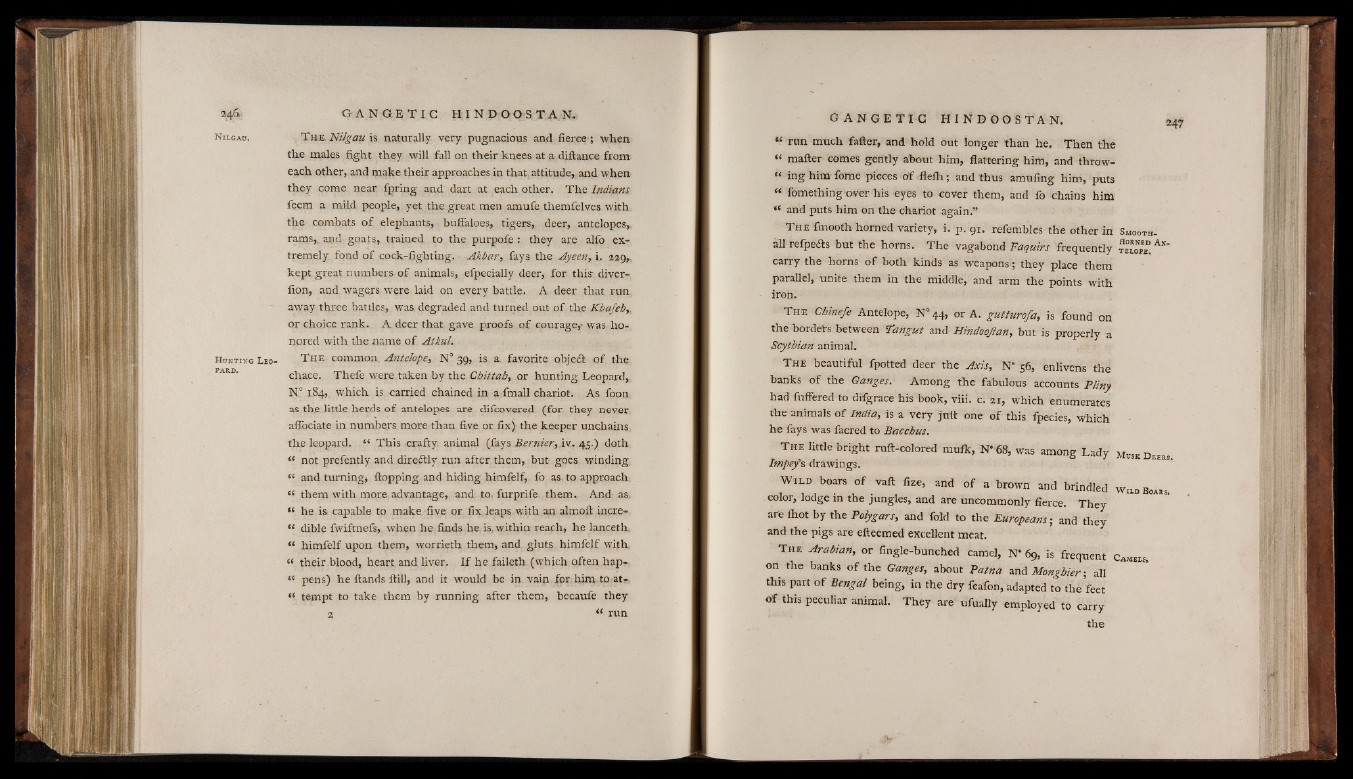
N ilg au .
H u n t in g Leo«
p a r d .
T h e Nilgau is naturally very pugnacious and fierce; when
the males fight they will fall on their knees at a diftance from
each other, and make their approaches in that attitude, and w hen
they come near fpring and dart at each other. The Indians
feem a mild, people, yet the great men amufe themfelves with
the combats o f elephants, buffaloes, tigers, deer, antelopes,
rams, and goats, trained to the purpofe : they are alfo extremely
fond of cock-fighting. Akbar, fays the Ayeen, i, 229,.
kept great numbers o f animals, efpecially deer, for this- diver-
fion, and wagers were laid on every battle. A deer that run
away three battles, was degraded and turned out ,of the Kbafeh,,
or choice rank. A deer that gave proofs o f courage,- was honored
with the name of AtkuL
T h e common. Antelope, N° 39, is a favorite objecft of the
chace. Thefe were taken by the Cbittab, or hunting Leopard,
N.° 184, which is carried chained in a fimall chariot. As foon
as the little herds o f antelopes are difcovered (for they never
aflociate in numbers more than five or fix) the keeper unchains
the leopard. “ This crafty, animal (lays Bernier, iv. 45.) doth
“ not prefently and directly run after them, but goes winding;
“ and turning,, flopping and hiding himfelf, fo as to approach;
“ them with more advantage, and to, furprife them. And as,
“ he is capable to make five or fix leaps with an almoft incre-
“ dible fwiftnefs, when he finds he is, within reach, he lanceth
“ himfelf upon them, worrieth them, and gluts himfelf with
“ their blood, heart and liver. I f he faileth (which often hap-
« pens) he ftands ftill, and it would be in vain forhim to at»,
“ tempt to take them by running after them, becaufe they
2 “ run
1 1
“ run much fafter, and hold out longer than he. Then the
“ mafter comes gently about him, flattering him, and throw-
“ ing him fome pieces o f fleih; and thus amufing him, puts
“ fomething over his eyes to cover them, and fo chains him
<e and puts him on the chariot again.”
T h e fmooth horned variety, i. p. 91. refembles the other in Smooth-
all refpedts but the horns. The vagabond Faquirs frequently An"
carry the horns o f both kinds as weapons; they place them
parallel, unite them in the middle, and arm the points with
iron.
T h e Cbinefi Antelope, N°44, or A. gutturofa, is found on
the borders between Pangut and Hindoojlan, but is properly a
Scythian animal.
T he beautiful fpotted deer the Axis, N- 56, enlivens the
banks o f the Ganges. Among the fabulous accounts Pliny
had fuffered to difgrace his book, viii. c. 21, which enumerates
the animals of India, is a very juft one o f this fpecies, Which
he fays was facred to Bacchus.
T he little bright ruft-colored muik, N* 68, was among Lady MvskDbbr,.
Impey's drawings.
W ild boats o f vaft fize, and o f a brown and brindled wiidb, « s.
color, lodge in the jungles, and are uncommonly fierce. They
are ihot by the Polygars, and fold to the Europeans; and they
and the pigs are efteemed excellent meat.
T h e Arabian, or fingle-bunched camel, N* 69, is frequent Cams«.
on the banks o f the Ganges, about Patna and Mongbier; all
this part o f Bengal being, in the dry feafoD, adapted to the feet
o f this peculiar animal. They are nfually employed to carry
the
111
I
1